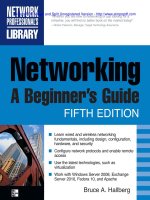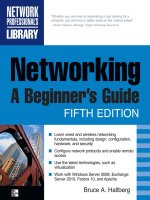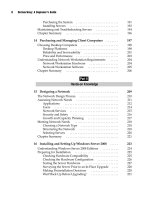Networking: A Beginner’s Guide Fifth Edition- P12 pdf
Bạn đang xem bản rút gọn của tài liệu. Xem và tải ngay bản đầy đủ của tài liệu tại đây (368.77 KB, 5 trang )
37
Chapter 4
Understanding
Network Cabling
38
Networking: A Beginner’s Guide
I
f you were to compare a computer network to the human body, the network cabling
system would be the nerves that make up the physical manifestation of the nervous
system. The network cabling system is what actually carries all the data from one
point to another and determines how the network works. How a network is cabled is of
supreme importance to how the network functions, how fast it functions, how reliable the
network will be as a whole, and how easy it will be to expand and change the network.
With any new network, your first task after assessing the needs for the network is to
determine how the network should be wired; all the other components of the network
are then built on that foundation. This is much like the OSI seven-layer model you
learned about in Chapter 3, in that the network cabling makes up layer 1 (the physical
layer), and all the upper networking layers rely on it.
Many people think that network cabling is relatively simple. After all, what could
be simpler than running a wire between two points? However, as you will see, the
topic of network cabling encompasses more than meets the eye, and it’s an extremely
important area to get right. If you make mistakes selecting or installing network cable,
your network will likely be unreliable and may perform poorly. Because of the labor
costs involved in wiring a network, the best time to address any potential problems in
this area is well before they occur.
Understanding Cable Topologies
The word topology basically means shape, and the term network topology refers to the shape
of a network—how all of the nodes (points) of a network are wired together. Networks
may be wired in several different topologies, and the choice of a topology is often your
most important decision when you plan a network. The topologies have different costs
(both to install and maintain), levels of performance, and levels of reliability.
DEFINE-IT! Network Segment
The term network segment can mean somewhat different things depending on the
topology of the network, but the concept is simplest to understand when thinking
about a bus network, and is essentially the same for any topology. A segment is
a single length of cable to which all the nodes in that segment are connected. In
truth, a segment is not a single continuous length of cable, because it is broken at
each computer connection point with a connector that lets the node connect to the
network cable, but the cable is electrically one single cable.
In any given segment, all the network traffic is “seen” by all the nodes on that
segment. You need to take this into account when planning how many nodes you
will connect to any given segment. If you have 20 computers, all fully using that
segment at the same time, each computer will achieve only approximately one-
twentieth of the available maximum bandwidth. This is simplified; you will learn
more about how this works later in this chapter and in following chapters.
39
Chapter 4: Understanding Network Cabling
The main topologies in use today are bus, star, and ring. These topologies are
described in this section.
Bus Topology
A bus topology, more completely called a common bus multipoint topology, is a network
where, basically, a single network cable is used from one end of the network to the
other, with different network devices (called nodes) connected to the cable at different
locations. Figure 4-1 illustrates a simple bus topology network.
Different types of bus networks have different specifications, which include the
following factors:
N How many nodes can be in a single segment
N How many segments can be used through the use of repeaters
N How close nodes can be to each other
N The total length of a segment
N Which coaxial cable type is required
N How the ends of the bus must be terminated
Bus topology networks use coaxial cable, described later in this chapter. Each end
of each segment of the network has a special cable terminator on it, without which
the network will not function. Some bus topology networks, such as Thin Ethernet
(10Base-2) use BNC connectors to tie all the individual pieces of cable together. Each
computer is connected to the network through the use of a BNC T-connector (called that
because it’s shaped like the letter T), which allows the network to continue its bus and
lets the computer connect to it. Figure 4-2 shows several different BNC connectors.
Figure 4-1. A simple bus topology network
40
Networking: A Beginner’s Guide
Bus network topologies are by far the least expensive to install because they use
much less cable than the other two topologies and, accordingly, use less material and
need less installation labor.
But bus networks have some big drawbacks. Because all the subcables that make
up the segment and run from node to node must be connected at all times, and because
a failure in any part of the segment will cause the entire segment to fail, bus networks
are prone to trouble. And even more important, that trouble can take a long time to
track down, because you must work your way through all the cable connections until
you find the one causing the problem. Often, the source of the problem isn’t visually
apparent, so you need to use various techniques and equipment to find it (as discussed
in the “Troubleshooting Coaxial Networks” section later in this chapter).
Because of the tendency of bus networks to be unreliable, new network wiring
installations do not use bus topologies, although many older networks still do.
Figure 4-2. BNC connectors used in a coax-based bus topology network
DEFINE-IT! BNC Connectors
Depending on whom you ask, BNC stands for Bayonet Nut Connector, British
Naval Connector, or Bayonet Neill-Concelman (with the latter two words standing
for its inventors, Mr. Paul Neill of Bell Labs and Carl Concelman of Amphenol
Corporation). BNC is a bayonet-style connector that quickly attaches and detaches
with a quarter turn. A variety of different parts—T-connectors, barrel connectors,
elbow connectors, cable ends that splice onto appropriate cable, and so forth—use
BNC connectors, so you can achieve nearly any type of connection needed. The
BNC connector is extremely easy to use and makes a secure connection.
41
Chapter 4: Understanding Network Cabling
By far, the most prevalent bus network used in the past (and in limited existence
today) is one called 10Base-2 Ethernet, or more commonly, Thin Ethernet. This network
type has the following characteristics:
N Has a rated maximum speed of 10 Mbps
N Uses RG-58/AU or RG-58/CU coaxial cable and BNC connectors
N Requires a 50-ohm terminating connector at each end of each segment to function
N Can handle a maximum of 30 nodes per segment
N Can be run up to a maximum segment length of 185 meters (607 feet)
N Can use extended segments through the use of repeaters
N Requires each node to be at least 0.5 meter (1.5 feet) of cable distance from any
other node
If repeaters are used, you can connect a maximum of three segments together, and
each segment may have up to 30 nodes (with the repeater counting as a node). You can
also have two additional segments (a total of five) if those extra two segments are used
for distance only and do not have any nodes on them. An entire repeated segment must
never exceed a total of 925 meters (3,035 feet). Remember the 5-4-3 rule: five segments,
four repeaters, three populated segments.
NOTE Repeaters are hardware devices that electrically boost the signal on a cable so it can be
extended further; they do not route any of the data. In fact, a repeater is “ignorant” of any of the
data it carries. Repeaters are inexpensive and reliable. However, remember that extending a cable
with a repeater means that all the network traffic on one side of the repeater is echoed to the cable
on the other side of the repeater, regardless of whether that traffic needs to go on that other cable.
Repeaters are discussed in more detail in Chapter 6.
Star Topology
A star topology is one in which a central unit, called a hub or concentrator, hosts a set of
network cables that radiate out to each node on the network. Technically, the hub is
referred to as a multistation access unit (MAU), but that particular terminology tends
to be used with only Token Ring networks, which use a logical ring topology (see the
following section). Each hub usually hosts about 24 nodes, although hubs range in size
from 2 nodes up to 96 nodes. Regardless of the hub size, you can connect multiple hubs
together to grow the network in any way that makes sense. See Chapter 6 for more on
connecting hubs together in different configurations. Figure 4-3 shows a simple star
topology network.
All the network traffic used on any of the network connections to the hub is echoed
to all the other connected nodes on that particular hub. Because of this, all the bandwidth
of any single node’s connection is shared with all other node’s connections. For example,
if one of the nodes connected to the hub is using half the available bandwidth, all the









